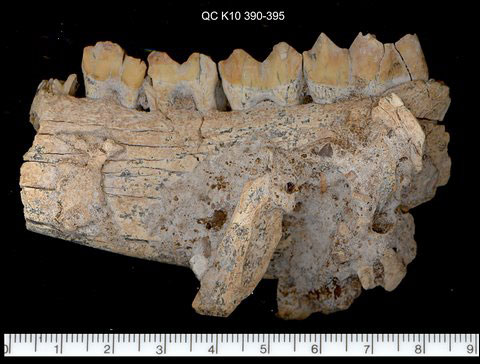Qesem Cave ("Qesem" means "surprise") people hunted cooperatively, then carried the highest quality body parts of their prey to the cave, where they cut the meat with stone blade cutting tools and cooked it with fire.
"The Lower Paleolithic (earlier) hunters were skilled hunters of large game animals, as were Upper Paleolithic (later) humans at this site," UA anthropology professor Mary C. Stiner says. Even then, humans were at the top of the food chain. Meat is one of the highest quality foods that humans may eat, and it is among the most difficult resources to harvest from the environment.
Archaeologists know that the roots of carnivory stretch deep into the past but the details of carnivory and meat sharing have been sketchy. And they are important details, because they reflect the evolutionary development in human economic and social behaviors.

Qesem cave deer jaw. Credit: Qesem Cave Project, TAU.
The cave was discovered in hilly limestone terrain about seven miles east of Tel-Aviv almost a decade ago during road construction. Stiner was invited by Ran Barkai and Avi Gopher of Tel Aviv University's Institute of Archaeology to participate in the Qesem Cave Project.
Stiner analyzed the pattern of cut marks on bones of deer, aurochs, horse and other big game left at Qesem Cave by hunters of 400,000 to 200,000 years ago. By analyzing the cut marks, she says she was able to understand meat-sharing behaviors between the earlier and later cooperative hunting societies and the patterns revealed a striking difference in meat-sharing behaviors: The earlier hunters were less efficient, less organized and less specialized when it came to carving flesh from their prey.
Random cut marks, and higher numbers of cut marks, made by the earlier hunters show they attached little social ritual or formal rules to sharing meat, Stiner said. Many hands, including unskilled hands, cut meat off the bone during feeding.
By contrast, by later times, by the Middle and Upper Paleolithic, "It's quite clear that meat distribution flowed through the hands of certain butchers," Stiner said. "The tool marks made on bones by the more recent hunters are very regular, very efficient and show much less variation in the postures of the individuals cutting meat from any one bone. Only certain hunters or other fairly skilled individuals cut meat that was to be shared among the group."
Stiner stresses that her new findings need to be more broadly replicated.
"It's interesting that these earlier people were skilled predators and very social, but that their social rules are more basic, less derived than those of the Middle Paleolithic. What might surprise most archaeologists is that I'm seeing a big difference between Lower and Middle Paleolithic social behaviors, not between Middle and Upper Paleolithic social behaviors.
"Neanderthals lived in the Middle Paleolithic, and they were a lot more like us in their more formal redistributions of meat than were the earlier hominids."
Article: Stiner, Barkai and Gopher, "Cooperative hunting and meat sharing 400-200 kya at Qesem Cave, Israel", Proceedings of the National Academy of Sciences.





Comments